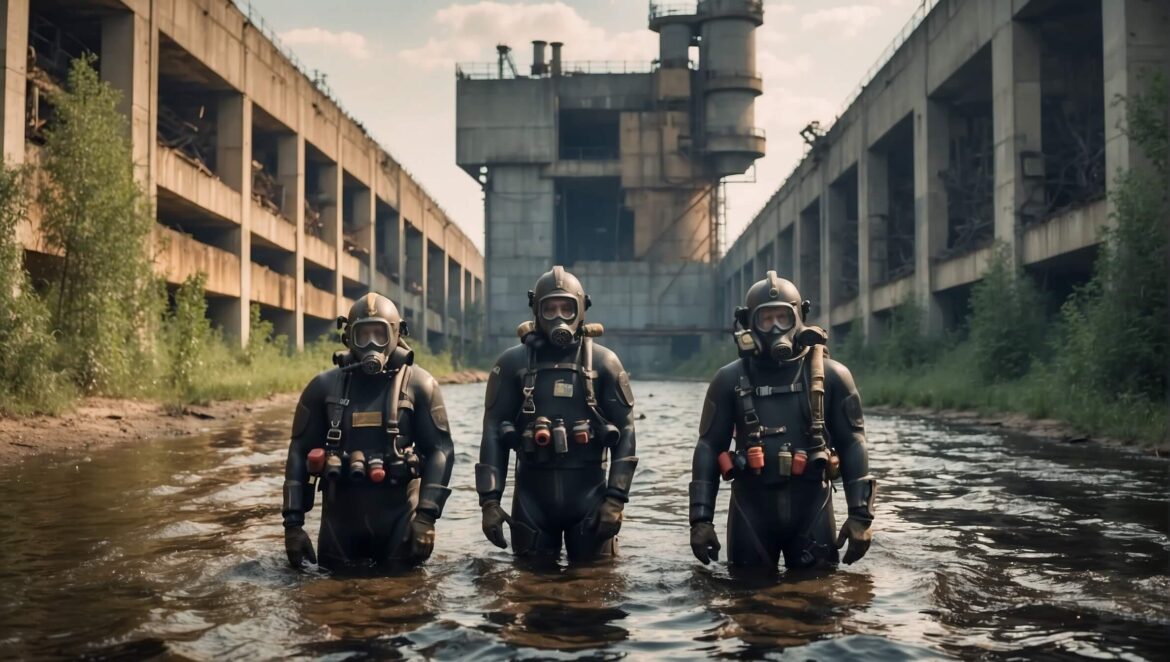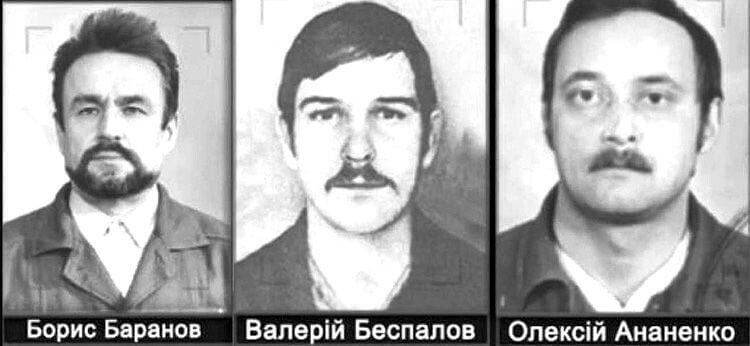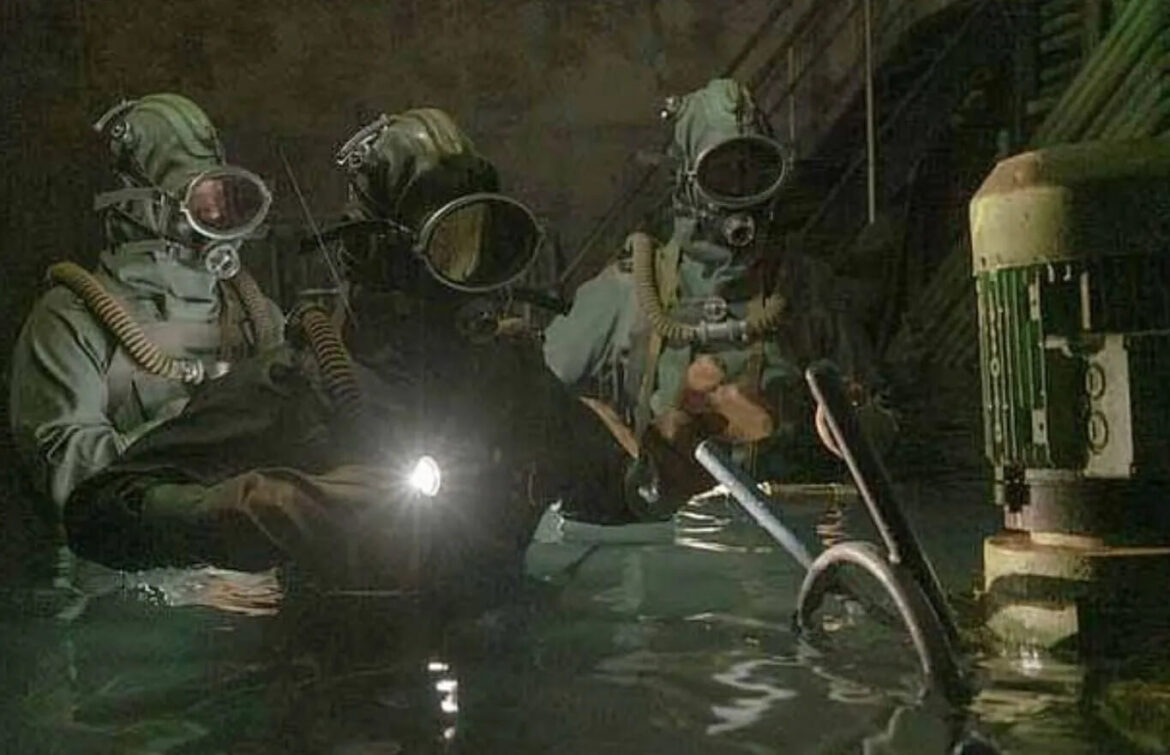Chernobyl’s Precipice: The Urgent Need for Divers

On a fateful April night in 1986, the Chernobyl Nuclear Power Plant witnessed an unprecedented disaster that not only shook the very foundations of nuclear safety but also etched a permanent scar on human history. Amidst the chaos and the radiation that enveloped the skies, a critical situation was unfolding beneath the surface, in the depths of the Chernobyl basement. It was here that the stage was set for an extraordinary tale of courage and sacrifice, a story that would later be whispered and recounted in awe for generations.
It was within this dire context that three men, often referred to as the 3 Chernobyl divers, and sometimes dubbed the ‘Chernobyl suicide squad, were called upon to undertake a mission so perilous, it seemed almost beyond the realms of human capability.
These were not just any divers; they were the 3 men who saved Chernobyl from an even greater disaster. As history watched with bated breath, the question lingered – what happened to the Chernobyl divers? Did they emerge as mere footnotes in the vast chapters of the Chernobyl saga, or did their bravery illuminate the darkest hours of this tragedy? This introduction is but a prelude to the extraordinary saga of resilience, duty, and the indomitable human spirit that defined the true essence of the Chernobyl divers’ mission.
Mobilizing Chernobyl’s Brave Swimmers: A Mission Unfolds

As the dust settled from the initial blast that tore through the night at Chernobyl, a new, silent peril began to unfold beneath the wreckage. The basement of the reactor, a concrete labyrinth, was slowly succumbing to a deluge of highly radioactive water. This wasn’t just any flood; it was a ticking time bomb. If left unchecked, the mingling of this contaminated water with the molten core could trigger a secondary explosion, one that could dwarf the initial disaster and spread radioactive fallout even further across Europe. The stakes couldn’t have been higher, and the clock was ticking mercilessly.
Enter the three divers destined to become synonymous with unparalleled bravery: Alexei Ananenko, Valeri Bezpalov, and Boris Baranov. These were not seasoned heroes of lore, but ordinary individuals, engineers, and workers at the plant, who found themselves standing at the precipice of a potentially global catastrophe. They were the chosen ones, not by fate but by necessity, tasked with a mission so daunting that it seemed almost otherworldly.
As the three Chernobyl divers descended into the abyss of the reactor’s flooded basement, they were met with conditions that were nothing short of nightmarish. The murky waters through which they waded were not just laden with debris and the remnants of a facility in ruins; they were saturated with lethal levels of radioactivity, a silent killer that permeated every drop.
Visibility was virtually nonexistent, a fact that transformed their mission into a blind groping through the dark, with only the dim glow of their flashlights piercing the oppressive blackness. The water, thick and heavy with radioactive particles, seemed to cling to them, an ever-present reminder of the invisible hazard that surrounded them at every turn.
The Chernobyl diver suits they wore, while designed to provide some level of protection against radiation, were grossly inadequate for the magnitude of the danger they faced. These divers’ suits, more suited for conventional diving operations, were ill-equipped to shield them from the intense radiation that filled the basement like an invisible fog. The protection they offered was minimal, a mere token against the onslaught of radioactivity that bombarded their bodies with every passing second.
Every step forward was a gamble, a delicate dance with death as they navigated through the submerged corridors, feeling their way towards their objective. The task for Chernobyl divers was straightforward in theory but monumentally complex in practice: locate and open the critical valves to drain the water and avert the impending secondary explosion. But in the pitch darkness, with the omnipresent threat of radiation, and the physical and psychological toll it exacted, the mission felt more like an odyssey through an underworld.
In this dire setting, the Chernobyl divers pressed on, driven by a sense of duty that transcended personal safety. Their mission was not just about navigating through the treacherous waters; it was a race against time to prevent a catastrophe of unimaginable scale. As they moved forward, inch by painstaking inch, they carried not just the hope of averting further disaster but the weight of the countless lives that hung in the balance.
Chernobyl Retold: Divers in Reality vs. HBO’s Drama

Scene from HBO Chernobyl series
The tale of the 3 Chernobyl divers, immortalized by the harrowing mission they undertook in the reactor’s flooded basement, found a new audience through the gripping narrative of the HBO series ‘Chernobyl’. This dramatized portrayal brought the story of the 3 men who saved Chernobyl from a potential second disaster to living rooms across the globe. However, as with any adaptation, the line between reality and fiction can sometimes blur, leading to a portrayal that, while compelling, doesn’t always align with the actual events.
In the series, the Chernobyl divers are depicted as volunteers who are fully briefed on the lethal risks of their mission, a dramatization that heightens the tension and underscores their heroism. They are shown donning their Chernobyl diver suits, aware that it might be a one-way journey into the radioactive waters of the Chernobyl basement. This portrayal paints a picture of ultimate sacrifice, of men stepping forward with full knowledge that their lives were likely forfeit in the service of a greater good.
However, real-life accounts from the divers and other sources offer a slightly different perspective. Alexei Ananenko, one of the divers, has stated in interviews that they were not volunteers in the heroic sense often depicted in popular culture. Instead, they were part of the plant’s staff, individuals with the necessary knowledge and clearance to undertake such a mission. Their decision to dive was less about volunteering in the face of certain death and more about performing a duty they were uniquely qualified for, under extraordinary circumstances.
Furthermore, the real-life divers’ awareness of the mission’s dangers, while certainly present, might not have been as stark or as fully comprehended as the series suggests. The Chernobyl basement’s conditions, the effectiveness of their diver suits against radiation, and the exact nature of the risks involved were not as clearly understood at the time, given the unprecedented nature of the disaster. The series, in its bid to convey the gravity of the situation, may have amplified the divers’ understanding of the risks involved.
The term ‘Chernobyl swimmers’, often used in media portrayals, evokes a certain romanticism, a heroic dive into danger. Yet, the reality was a grim and hazardous wade through dark waters, not fully knowing what lay ahead or the full extent of the danger. This distinction between the dramatized heroism and the more complex, nuanced reality captures the essence of what happened to the Chernobyl divers. Their bravery is undeniable, but the context of their actions, the mix of duty and necessity, paints a more complex picture of heroism in the face of disaster.
The Chernobyl Divers’ Aftermath

Oleksyi Ananenko
In the years that followed, the fate of these divers became the subject of much speculation and myth-making. Rumors swirled about their health, their survival, and the long-term effects of the radiation they were exposed to. Some stories suggested that they succumbed soon after their mission, martyrs to the cause of averting further disaster. However, the reality is both more complex and more hopeful.
Alexei Ananenko and Valeri Bezpalov survived the ordeal, defying the grim expectations that surrounded the mission. Their survival is a testament to the unpredictable nature of radiation exposure and the human body’s resilience. Boris Baranov, on the other hand, passed away in 2005, but not from causes directly related to radiation sickness, as one might expect. This clarification is crucial in debunking the myths that have long clouded the narrative of what happened to the Chernobyl divers.

Bespalov Valeryi
The long-term health impacts on Ananenko and Bezpalov, while influenced by their exposure during the mission, did not follow the fatal trajectory often associated with such high-risk radiation encounters. This outcome challenges the narrative of inevitable doom that often accompanies discussions about the Chernobyl disaster and those who braved its aftermath.
Their Chernobyl diver suits, while providing minimal protection, perhaps played a role in shielding them from the worst of the radiation, though the psychological and emotional toll of their mission is harder to quantify. The label ‘Chernobyl swimmers,’ often used to describe these men, barely scratches the surface of their experience and the lasting impact it had on their lives.
The true story of the 3 divers who saved Chernobyl from an even greater catastrophe is not just a tale of survival against the odds; it’s a narrative that underscores the complexity of human resilience in the face of unimaginable challenges. As we look back on their mission, it’s important to remember not just the immediate aftermath but the enduring legacy of their courage and the nuanced reality of their lives post-Chernobyl.
Honoring Chernobyl’s Guardians: The Divers’ Enduring Legacy
As we reflect upon the harrowing tale of the 3 Chernobyl divers, it becomes evident that amidst the backdrop of disaster, the human spirit shines brightest. The story of these three divers—ordinary individuals who found themselves at the crossroads of history—is a profound testament to the themes of bravery, duty, and the indomitable will to confront extraordinary danger for the sake of the greater good.
The actions of the Chernobyl divers in the dark, radioactive waters of the Chernobyl basement were driven by an unwavering sense of responsibility. Clad in their Chernobyl diver suits, they ventured into the unknown, not as invincible heroes, but as humans, vulnerable yet unyielding in the face of peril. Their legacy is not solely defined by the disaster they helped avert but by the sheer force of their will to act in the face of overwhelming odds.
The term “Chernobyl swimmers,” while evocative, barely scratches the surface of the sacrifice and courage embodied by these men. Their story is a powerful reminder of the capacity for heroism that lies within each of us, often emerging in the most dire of circumstances.
As visitors walk the desolate landscapes of Chernobyl, the echoes of the past linger in the air, inviting reflection on the human stories that shaped the course of the disaster. The legacy of the 3 divers who saved Chernobyl is etched into the very fabric of this place, serving as a poignant reminder of the depth of human courage.
The question of what happened to the Chernobyl divers after their mission is a part of their story, but the impact of their actions extends far beyond. They remind us that even in the darkest moments, the human spirit is capable of extraordinary feats of bravery and selflessness.
As we stand amidst the remnants of Chernobyl, let us remember the 3 Chernobyl divers not just for the disaster they helped contain but for the enduring message they left behind—a message of hope, resilience, and the unyielding capacity of humans to rise above and confront the challenges before them, no matter the odds. Their legacy is a beacon for all who face adversity, a testament to the power of the human spirit amidst disaster.
- - Hostomel
- - Irpin
- - Bucha
- - Romanivka
- - Borodyanka
















Total comments: 0